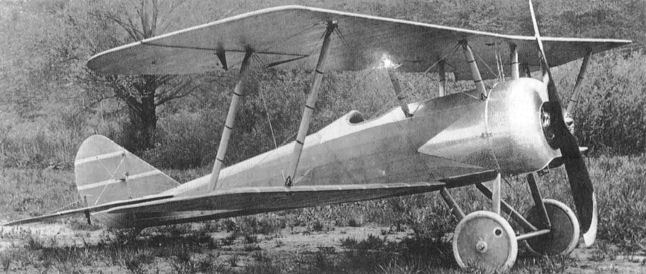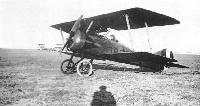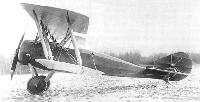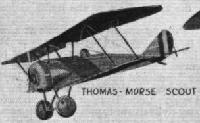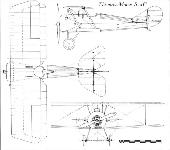А.Шепс Самолеты Первой мировой войны. Страны Антанты
Компания, образованная в 1914 году, начинала с лицензионного производства в небольшом количестве самолетов английских фирм "Виккерс" и "Сопвич". Первый собственный самолет фирма выпустила в 1917 году. Это был учебный одноместный самолет S-4 "Скаут", одностоечный биплан цельнодеревянной конструкции.
Фюзеляж прямоугольного сечения с полукруглым гаргротом, обтягивался полотном. Капот двигателя алюминиевый. Крыло двухлонжеронное деревянное, с полотняной обтяжкой. Элероны только на верхнем крыле. Хорда нижнего крыла несколько меньшей длины. Оперение обычного типа со стабилизатором и килем. Шасси обычное, со сплошной осью и резиновой шнуровой амортизацией. Двигатель 9-цилиндровый, воздушного охлаждения, звездообразный, ротативный "Рон 9С" (105л. с.). Опытный самолет был поплавковый, однако для армии было заказано первоначально 50 колесных машин S-4B. Вскоре заказ был увеличен до 150 штук.
Следующей серией стали 447 машин S-4C учебных самолетов для USA AS. Последней серией были машины S-4E с крылом большего размаха и одним синхронным пулеметом, учебный истребитель. На этих машинах впервые устанавливались фотопулеметы для определения результатов учебного боя.
Показатель S-4C "Скаут" 1917г.
Размеры, м:
длина 5,60
размах крыльев 8,10
высота 2,5
Площадь крыла, м2 21,7
Вес, кг:
максимальный взлетный 623
пустого 438
Двигатель: "Рон" 9С
мощность, л. с. 102
Скорость, км/ч 156
Потолок практический, м 4500
Экипаж, чел. 1
Вооружение 1 пулемет
Показать полностью
J.Wegg General Dynamics Aircraft and Their Predecessors Since 1912 (Putnam)
S-4 Series
In late 1916, B Douglas Thomas designed a conventional biplane scout trainer around the 100hp General Vehicle Company-built nine-cylinder Gnome rotary engine. The prototype was tested in spring 1917 at Ithaca by Frank Burnside. In June 1917, it was evaluated by the Army at Hampton, Virginia, as an advanced trainer. The prototype's Gnome engine was unsuitable for cruising and it suffered from a 5 lb or 6 lb tail-heavy condition, therefore it was only used for short exhibition and training flights, accumulating a total of 250 hours by the time it was scrapped.
At the request of the Engineering Division, a number of changes were made to the design including shortening of the fuselage by 2ft 9in, replacement of the Deperdussin-type control wheel with a stick, reduction in area of the ailerons, elevators and rudder, and trailing edges changed from wood to steel. In this form, one hundred S-4Bs (4276/4375) were ordered on 3 October and a second prototype incorporating all the specified revisions was flown in November. This, however, crashed on landing at Cornell University on 21 December, 1917, when being flown by Tex Marshall, and was destroyed.
The wings of the S-4B were said to have the largest stagger of any aircraft built up until then, but structural tests with sandbags weighing over seven times the aircraft weight proved that there was no weakness. The fuselage was built of spruce and ash member with fabric covering except for an aluminium firewall and cowling. One S-4B (4355) was tested at McCook Field as P-26.
These were followed by fifty S-4Cs (41359/41408) with push rods and torque tubes for aileron control, similar to the Nieuport, an example of which had been sent to Ithaca, and provision for one Marlin 0.30in gun.
The Gnome had proved troublesome, using 3 gallon of castor oil an hour and depositing a fine spray of it over the starboard wing and cockpit. The high-pressure fuel system when fractured in an accident would also spray fuel over the hot engine. Therefore, a further 447 S-4Cs (36509, 38633/38982, 44578/44674) were delivered with a 90hp Le Rhone C-9, which only consumed one gallon of oil an hour, built by the Union Switch and Signal Co, Swissvale, Pennsylvania. Another 500 were cancelled, after over half the parts had been already made, and one more S-4C was completed by the company as a demonstrator, making a total of 601 S-4/B/Cs built. Large quantities were used at Carlstrom Field, Arcadia, Florida; Gerstner Field, Lake Charles, Louisiana; and Rockwell Field, San Diego, California. The Navy also used ten S-4Bs (BuA 3235/3244) and four S-4Cs (BuA 5855/5858) diverted from Army stocks. Noted for its relatively high speed, climbing ability and reasonably fine handling in the air, the 'Tommy Scout' retained the tail-heavy condition of the prototype and was prone to ground looping.
Following tests at Cayuga Lake with the prototype S-4 fitted with twin floats, six S-5s (BuA-757/762) were built in 1918 for the Navy. These were basically S-4Bs with triple floats copied from the Sopwith Baby and were used at NAS Dinner Key, Miarni. At least one (A-758) flew with a revised rudder which was taller, but of reduced span.
During summer 1918 and the immediate postwar period, several designs based on the S-4 basic concept were completed. The S-4E was an aerobatic trainer with a 110hp Le Rhone, tapered wings and redesigned tail surfaces similar to the SPAD, and a new undercarriage. The top wing had a span of 22ft and the lower 14ft. Possessing a marked tail-heaviness and inadequate propeller ground clearance, it was sold engineless to Basil Rowe.
The S-6, with two single-seat cockpits and dual controls, fuselage lengthened by 10in and a wing span of 29ft, was intended as a civil sport/training type and was powered by an 80hp Le Rhone. Entered in the 1919 National Air Races at Kansas City, it came second and it was flown by Paul D Wilson from Ithaca to Washington on 30 April, 1920, and on to McCook Field on 10 May to demonstrate its cross country ability. Top speed was 105mph and its ceiling was almost 20,000ft. Later registered C98, the S-6 was used by the Ithaca Flying Service, then sold to Fred Krehnlein of Rochester, New York, in 1931, and crashed after a low-altitude spin.
The similarly-powered, 32ft-span S-7 accommodated the pilot and passenger in a single wide cockpit and was advertised as the Sociable Seater. The S-7 was designed by W T Thomas, Agnew Larsen, and Raymond Dowd, and completed in 29 days after work started. First flown by Tex Marshall, it was eventually sold to Basil Rowe and Clarence Chamberlain and used for aerial mapping.
Using the wings from the S-6 and standard S-4C tail surface, but with a side-by-side two-seat cockpit and powered by a 200hp Lawrance J-1, the S-9 trainer of 1923 featured a wraparound corrugated sheet metal fuselage in a conventional configuration to respond to current Army interests. The company-owned prototype was tested at McCook Field as P-313 and later at Kelly Field, Texas, and finally written off in a crash following failure of a wing strut attachment fitting.
The S-4 series was popular on the secondhand market and over sixty were registered to private owners until grounded by the increased stringency of regulations in the late 1920s. Some were re-engined with the SuperRhone ZR-l and ZR-2, radials converted from rotaries by Tips and Smith Inc, Houston, Texas. Many S-4s were converted with 90hp Curtiss OX-5 water-cooled engines, some with a second seat behind the pilot. Another side-by-side two-seat version using the OX-5 was manufactured by the Yackey Aircraft Company, Maywood Field, Illinois, as the Yackey Sport. Several were produced as Dycer Sports by Charles Dycer at Dycer Field, Los Angeles, in 1926-27. Private owners made innumerable modifications and some S-4s were converted into parasol monoplane configuration. One such conversion was fitted with an arcurate control system, designed by R C Stroop, in Alabama in 1932. The upper wing panels of S-4Cs were used on the initial examples of the popular Heath Parasol built in 1927 and several S-4Cs were used by Hollywood for film making. One was leased to Northwest Airways for one month in October 1926 to start mail services.
Also favoured for air racing, one S-4C flown by H F Cole came second in the On to St Louis race at the 1923 National Air Races. Another, registered G-CAEH, was entered at Dayton in 1924 and an S-4C modified with a Curtiss OX-5 came second in the On to Dayton race, flown by Charles Holman. For the following year's races, Basil L Rowe modified the S-4E with a 135hp Aeromarine 737 liquid-cooled V-8 engine. Named Space-Eater, it won first place in the Free-for-All race at Mitchel Field, New York, averaging 102.9mph. Second in the event was a S-4B (Curtiss OX-5) flown by E P 'Bert' Lott. Rowe won the B B T Trophy race at Philadelphia with Space-Eater in 1927.
A number of S-4s are extant in museums in the United States and two are still regularly flying in the Spokane, Washington, area, and at Old Rhinebeck, New York.
S-4C
Span 26ft 8in; length 19ft 10in; height 8ft 1in; wing area 234sq ft .
Weight empty 963 lb; gross weight 1,373 lb.
Maximum speed 95mph; climb 7,500ft/10min; service ceiling 15,000ft.
Показать полностью
G.Swanborough, P.Bowers United States Military Aircraft Since 1909 (Putnam)
Thomas-Morse S-4 Series
The Thomas S-4, designed by B. Douglas Thomas, was conceived late in 1916 as a Scout to be powered with the 100 h.p. French Gnome rotary engine then being manufactured in the U.S. The single prototype was evaluated by the Army but was rejected as a combat type in favour of more up-to-date European designs. However, the training requirements of the expanding aviation programme of 1917 resulted in production orders from the merged Thomas-Morse Company. The 100 S-4Bs were identical to the prototype except for a considerably shortened fuselage. Structure was all wood with fabric covering. S-4Bs on small twin floats and a tail float were supplied to the Navy as S-5s.
The S-4C was an improved B, the outward differences being straight instead of swept-back trailing edges to the ailerons, and aileron control by push rods and torque tubes in the manner of the French Nieuport 17, an example of which had been sent to the Thomas-Morse Ithaca factory. The first 50 S-4Cs used the 100 h.p. Gnome, but this troublesome power plant was replaced by the 80 h.p. Le Rhone when it became available. Armament was a single 0-30-inch Marlin machine gun or a camera gun. The S-4C contract for 1,050 aircraft was cancelled after the Armistice by which time 497 had been delivered, the final S-4C being numbered 44674.
The large size of the S-4 ailerons resulted in an odd marking situation. Under the initial specifications, the U.S. insignia was to be applied to the wing inboard of the ailerons. This resulted in the top wing markings almost touching at the centre section. Later 1918 applications were moved outward on the aileron.
The last variant, which the Army did not buy, was the speedy taperwinged S-4E. In post-war years this prototype was fitted with a 135 h.p. Aeromarine V-8 engine and used for racing. The S-4s were extremely popular on the surplus market and were widely flown as sport planes until grounded by the increasing stringency of safety regulations in the late 1920s. A few were converted to 3-place Dycer Sport Models by installation of a 90 h.p. Curtiss OX-5 in place of the rotary and the addition of a second 2-seat cockpit. S-4C upper wing panels were also used on the first models of the popular motorcycle-engined Heath “Parasol” lightplane of 1927. S-4Cs saw wide use in Hollywood war films of the 1930s, and a number have been restored by the antique aeroplane fans in the years since World War II.
TECHNICAL DATA (S-4C)
MANUFACTURER: Thomas-Morse Aircraft Corp., Ithaca, New York.
TYPE: Advanced trainer.
ACCOMMODATION: Pilot only.
POWER PLANT: 80-h.p. Le Rhone piston radial.
DIMENSIONS: Span, 26 ft. 6 in. Length, 19 ft. 10 in. Height, 8 ft. 1 in. Wing area, 145 sq. ft.
WEIGHT: Gross, 1,330lb.
PERFORMANCE: Max. speed, 97 m.p.h. Initial climb, 10 min. to 7,500 ft.
ARMAMENT: One Marlin 0-30-in. machine gun, or camera gun.
KNOWN SERIAL NUMBERS:
S-4B: 4276/4372 (plus three).
S-4C: 38637/38979; 39882; 41359/41408; 44608/44674. (plus six).
Показать полностью
G.Swanborough, P.Bowers United States Navy Aircraft Since 1911 (Putnam)
THOMAS-MORSE S-4B, S-4C
The S-4s were the Army's standard single-seat advanced trainers in 1917-18. The S-4B used the 100hp American-built Gnome rotary engine while most of the later S-4Cs used the more reliable 80 hp Le Rhone. Principal recognition feature was the use of sweptback ailerons on the S-4B. The Navy's use of ten S-4Bs (A3235-A3244) and four S-4Cs (A5855-A5858) was for fighter-pilot training, and armament was principally a camera gun. S-4C: span, 26 ft 6 in; length, 19 ft 10 in; gross weight, 1,330 lb; top speed, 97 mph.
Показать полностью
Jane's All The World Aircraft 1919
THE THOMAS-MORSE S.4 SCOUT BIPLANE
The S.4B (100 h.p. Gnome engine) and S.4C (80 Le Rhone engine) became standard single-seat fighter trainers with the US services from 1917. The details below apply to the S.4C version.
Type of machine Single-seater Scout trainer.
Name or type No. of machine S.4C.
Purpose for which intended Fighter training.
Span 26 ft. 6 in.
Overall length 19 ft. 10 In.
Maximum height 8 ft. 1 in.
Engine type and h.p. 80 h.p Le Rhone.
Weight of machine empty 940 lbs.
Petrol tank capacity in gallons 30 gallons.
Performance.
Speed (maximum) 97 m.p.h.
Landing speed 45 m.p.h.
Climb.
To 7,600 feet in minutes 10 minutes
Total weight of machine loaded 1.330 lbs.
Показать полностью
